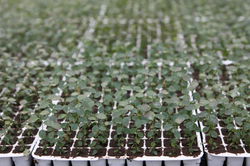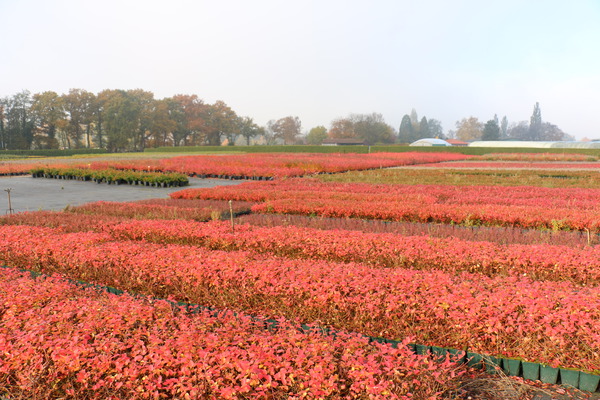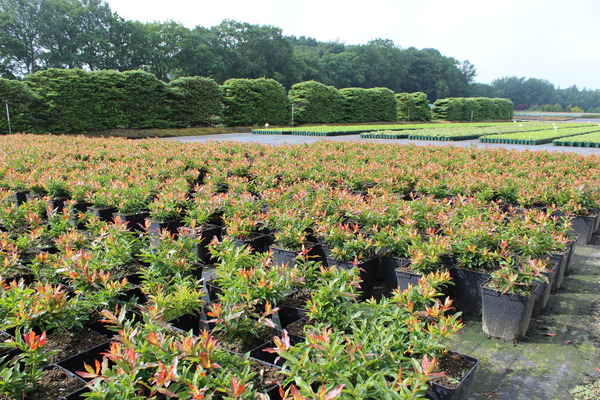 Why is it so important, especially when producing blueberries, to use the right size of blueberry young plants right from the start? In contrast to many types of soft fruit, such as raspberries, blackberries or gooseberries, blueberries grow much more slowly. Due to this fact, it is imperative to use the right blueberry young plant quality in order to yield a successful crop. Which blueberry young plants are right for you depends on the pot size of the end product.
Why is it so important, especially when producing blueberries, to use the right size of blueberry young plants right from the start? In contrast to many types of soft fruit, such as raspberries, blackberries or gooseberries, blueberries grow much more slowly. Due to this fact, it is imperative to use the right blueberry young plant quality in order to yield a successful crop. Which blueberry young plants are right for you depends on the pot size of the end product.
However, it is not only the choice of the correct blueberry young plants that is decisive for successful cultivation. Although this plays an important role, the earliest possible potting date is just as important in order to make full use of both growth spurts of the blueberries.
The different qualities of blueberry young plants

Especially when producing blueberries, it is important to use the right quality of blueberry young plants for a successful crop. Below we give you an overview of the blueberry young plant qualities offered by us and their possible applications.
Multi
The Multi quality is an annual, spring-propagated young plant in our standard 60-cell tray. This quality is available starting from the 22nd/23rd calendar week. These young plants are still very juvenile and accordingly vigorous. Since the plants are already in the first of two annual growth spurts at the beginning of delivery, there is only a small time frame for the ideally potting the blueberries in order to get the most out of these young plants.
Multi+
The Multi+ quality is a biennial, overwintered young plant in our 60-cell standard tray. This quality is available early after the turn of the year. Due to the long production period and the associated pruning, this blueberry young plant quality already has several shoots at the time of delivery. This makes it possible to achieve a bushy end product with many shoots. Due to an early delivery time and thus also an early potting time, the blueberry young plants of this quality can fully take advantages of the growth spurts, whereby a high-quality end product can be achieved.
HP18/T9
This is a strong but also overwintered young plant in an 18-cell tray, in which the individual cells correspond to the size of a 9 cm square pot. This quality is produced from our own young plants from the 60-cell tray. Thus we achieve a multi-shoot young plant, which guarantees a bushy end product with multiple shoots. Since this blueberry young plant quality is delivered in an overwintered state, delivery is already possible in early spring and thus an early potting date is also feasible so that both growth spurts of the blueberries can be fully utilised.
The pot size determines the quality of the young plants
However, not all blueberry young plant qualities are equally suitable for the different pot sizes, both for economic and cultivation reasons.
C2 or smaller
Pot/container sizes up to two litres can be produced very well from both the Multi and the Multi+ quality. Even with a late potting date until early/mid-July, when both growth spurts can no longer be used completely, cultivation success up to autumn is definitely guaranteed. In the case of late potting dates, however, a good supply of nutrients must be ensured, as this is the only way to safeguard ideal plant development.

Picture: production of blueberries at our sister company Lubera®
C3
Although other types of berries, such as raspberries, blackberries or gooseberries, can easily be produced in three litres of containers from our standard young plants in the 60-cell tray (Multi, Multi+), this does not apply to blueberries. Here even the Multi+ young plants tend not to be strong enough to achieve a good marketable quality by autumn.
For this container size it is recommended to use the strong blueberries of the young plant quality HP18/T9. This young plant quality virtually ensures that the plants reach a marketable quality by late summer/autumn. This also applies to very late potting dates at the end of June/beginning of July, as the last growth spurt in August is still to come.
C5/C7.5 or larger
With the strong blueberry young plant quality HP18/T9, larger containers of 5 or 7.5 litres can be easily produced. It should be noted, however, that the larger the container, the earlier the potting time should be. The better the two growth spurts (the first in late spring and the second in August) are used, the more time the plants get to develop. This ultimately leads to a better quality of the end product.
For even larger container sizes, it is advisable to produce two litre containers from the Multi or Multi+ quality, as described above, which in turn serves as a pot product for the large containers.

Picture: production of blueberries in C5
The sooner the better – order blueberry young plants from Lubera Edibles
It is always easy to say that the best option is to order young plants as early as possible. But nowhere is this truer than with the blueberry young plants. Here it is important to note that the actual rooting of the micro-propagated plants takes place up to 18 months (with the Multi+ quality) before the actual delivery of the young plants. The quantity planning thus starts even earlier.
The starting material, the in vitro plug, is already produced in late summer/autumn for blueberries. This plug is then brought to its natural ripening stage and already in late winter it is transferred to the standard tray and set up in an unheated foil house. The growth then begins with the natural, seasonal development. During the cultivation phase until late summer, the young plants are pruned two to three times in order to obtain a multi-stemmed plant. After the seasonal ripening and the natural leaf fall, the plants are ready for delivery.
Please let us know as soon as possible what your blueberry young plant requirements are, because as you have seen, it is hardly possible for us to adjust or increase our production quantities at short notice.
Click here for more information.
Would you like more information, an individual consultation or information about additional ranges?
Click here for the complete 2019 catalogue, which can be downloaded.
If you have specific questions, please do not hesitate to contact our customer service, where you can also spontaneously place an order.
And of course we are always there for you via telephone.
If you want to be regularly informed about news, etc., you can also subscribe to our gardener newsletter here, which we send out about once a month - it's worth it!
